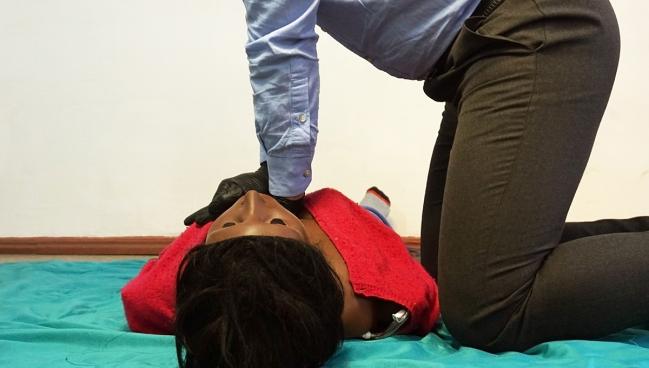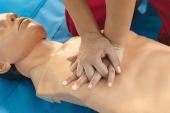CPR Manikins on Social Media Have a Diversity Problem
An analysis of social media posts by organizations that teach and certify for CPR feature mostly lean, white, adult males.

CPR education has a diversity problem, and social media images of slim, white, male manikins are only compounding the issue, new research makes clear.
In an analysis of Twitter and Instagram posts of organizations and businesses that administer CPR training and certification, only a fraction of the accompanying images included nonwhite or nonlean manikins, and none were of pregnant women.
Study after study has shown that race, wealth, neighborhoods, and education levels all have an impact on the woefully low use of resuscitation attempts in nonwhite individuals who suffer an out-of-hospital cardiac arrest (OHCA), a problem only compounded by the COVID-19 pandemic.
Great to be teaching vital life-saving #CPR skills to @bt_uk staff today. pic.twitter.com/YvTZjS9CV8
— Resuscitation Council UK (@ResusCouncilUK) November 16, 2022
An earlier study hypothesized that a lack of diversity in the manikins used for CPR training might shoulder some of the blame. DIVERSE I surveyed institutions, businesses, and nongovernmental organizations that certify CPR practitioners across North and South America and found that 88% of manikins used were white, 94% were male, and just 1% were pregnant. DIVERSE II, published this week in the Canadian Journal of Cardiology, took this one step further, looking at the photos and social media posts put out by these same organizations.
“Not to our surprise, because we had the knowledge from DIVERSE I, we did confirm that social media CPR is very closely associated with a lean, white individual,” senior author Adrian Baranchuk, MD (Kingston Health Sciences Center, Canada), told TCTMD. “There’s a lot of diversity in the person providing CPR, but there’s very little diversity, not more than 7%, for any other manikin that does not represent a white, lean man. So that’s kind of disturbing. If you walk out and you see a Black, pregnant lady on the floor, you may think that this is not cardiac arrest, this is something else, because you have not been taught—and social media has not [reinforced]—that sudden death is a problem that affects all in our community, with no distinction between gender or race or any other sort of distinction.”
Scrolling for DIVERSE II
For DIVERSE II, Baranchuk, with first author Shyla Gupta, BHSc (University of Ottawa, Canada), and colleagues, reviewed social media posts between September 2019 and September 2021 on Twitter and Instagram by the organizations first surveyed in DIVERSE I. Focusing only on posts that contained pictures (either educational posts, or posts advertising CPR classes), they identified a total of 211 images.
¡Manos que salvan vidas!
— CECAD Emergencias (@CECADemergencia) June 14, 2022
Aprende RCP con #CECADemergencias #CECAD #Emergencias #RCP #CPR #YoPuedoSalvarUnaVida
Contáctanos y cotiza tu curso al +521 5543244395 ☎️ pic.twitter.com/mzLJAzsgv4
Of these, just four posts (< 2%) pictured overweight or obese manikins and none showed pregnant adults. Just over 15% depicted female manikins, 6.6% showed children, 3.8% included Black manikins, and just 1.4% represented Asian subjects.
Even more jarringly, while images with white manikins received an average of 22.8 likes, 8.6 retweets, and 1 comment for every 10,000 followers, racially diverse manikins received just 4.6 likes, on average, 2.4 retweets, and 0.1 comments per 10,000 followers.
“The results of DIVERSE II indicate that a profound analysis of how we teach CPR, not only in organized courses but the way we distribute knowledge to our communities via social media, needs to be reviewed to be more inclusive and more representative of a real-life community,” Baranchuk told TCTMD.
There are myriad other factors that go into whether or not bystanders perform CPR, Baranchuk acknowledged, citing education and social/cultural concerns as contributing to the disparities in resuscitation efforts so well documented around the globe. Organizations already providing CPR certification and social media promotion may be reluctant to shell out the money to get new, more widely representative models, he added.
But fixing social media messaging would be one simple way to help this space be more inclusive, he said.
“If you see a nonresponsive person lying on the ground, not moving, you have to assume that’s a dead individual [someone whose heart has stopped] until you prove otherwise and you should start the chain of survival regardless of skin color or gender,” he said. “If you are trained in CPR, do exactly as you've been trained. If you are not, activate quickly the call to 911 and provide chest compressions to the best of your capacity without judging whether the individual is a male or a female or is white, Black, or any other color.”
But educators can step up their game, he urged, even if that means shelling out to replace older white manikins with newer ones that reflect the vastly different makeup of communities today.
“My hope is that the people receiving education and the people providing education can be inspired to rearticulate the teaching, to help us achieve a fairer outcome in terms of who receives CPR and who doesn’t,” he said, calling this study a “grain of salt” contribution to that goal.
An accompanying editorial notes that the use of “noninclusive manikins” in resuscitation training “reflects the wider issue of implicit bias” in medicine and beyond.
“This study by Gupta et al provides data to suggest that implicit biases in OHCA may exist insofar as they influence disparities in OHCA training, care, and outcomes,” write Nicholas Grubic, MSc (Queen’s University, Kingston, Canada), and colleagues. “Novel strategies that aim to alter the lack of diversity in resuscitation and OHCA should be a public health priority. Policies that promote diversity in medical education and simulation training are needed to spark collaboration between manufacturers, medical organizations, and clinical educators to provide inclusive learning environments.”
Shelley Wood was the Editor-in-Chief of TCTMD and the Editorial Director at the Cardiovascular Research Foundation (CRF) from October 2015…
Read Full BioSources
Gupta S, Al-Rawi R, Iomini P, et al. Determining the importance of various genders, races and body shapes for CPR education using mannikins: images in media (DIVERSE II). Can J Cardiol. 2022;Epub ahead of print.
Grubic N, Smith BT, Randhawa VK, et al. Removing the “man” in “manikin”: the importance of sociodemographic diversity in resuscitation training. Can J Cardiol. 2022;Epub ahead of print.
Disclosures
- Gupta, Baranchuk, and Grubic report no relevant conflicts of interest.





Comments